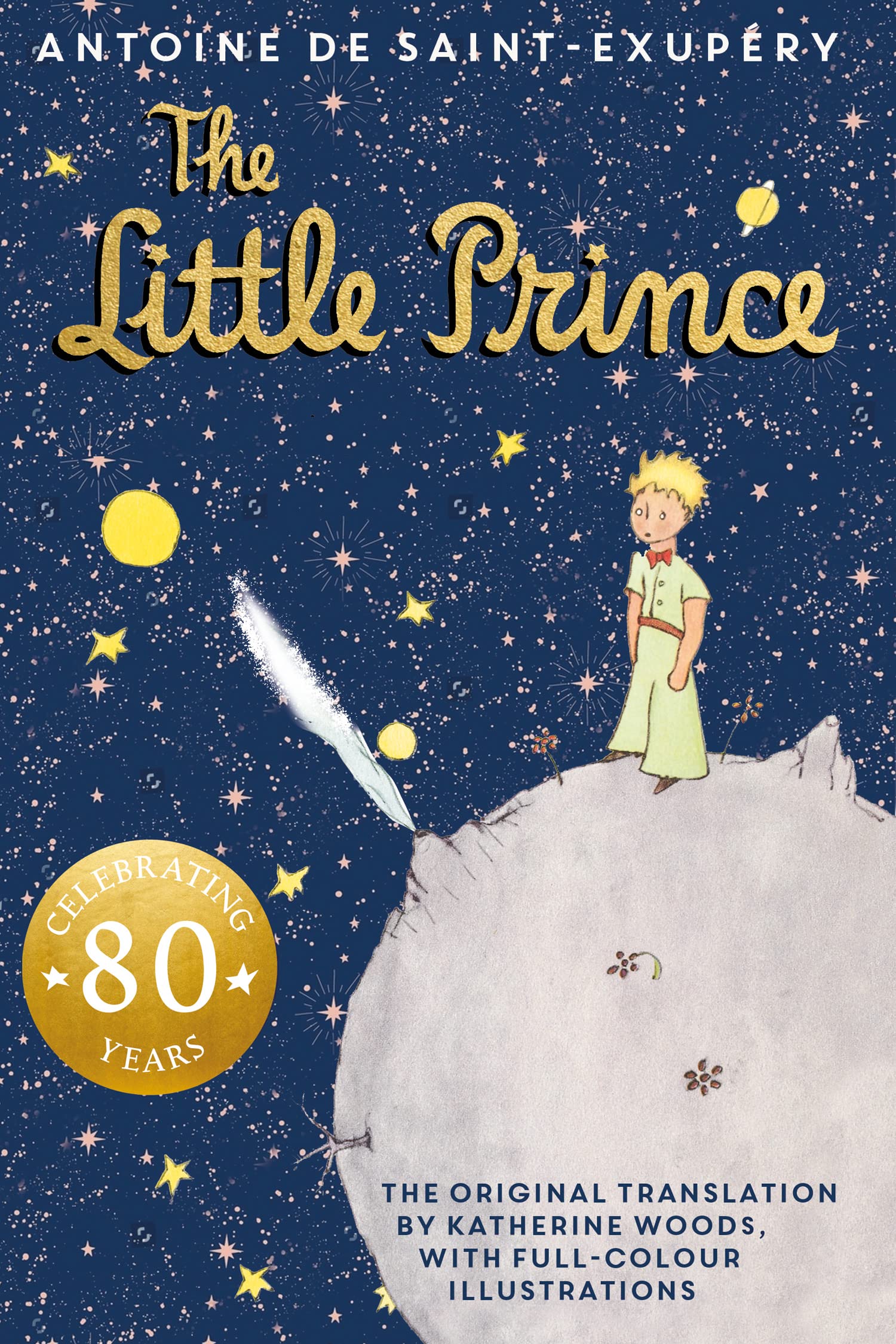Spoilers:
- The Little Prince dies from a snake bite
- Prince misses his rose on his planet
- Pilot crashes and meets the Prince
- The Prince visits various planets
- Each planet has a lonely adult
- They bond in the desert
- Makes pilot rethink life’s priorities
The Little Prince: Key Statistics
Publication Details
- Author: Antoine de Saint-Exupéry
- Original Language: French
- First Published: 1943
- Publisher: Reynal & Hitchcock (U.S.), Gallimard (France)
- Genre: Children’s literature, Allegory
Sales & Translations
- Copies Sold: Over 140 million worldwide
- Translations: Available in more than 300 languages and dialects
- Global Reach: One of the best-selling books in history
Adaptations
- Film Adaptations: Several, including a 2015 animated film
- Stage Productions: Numerous theatrical adaptations
- Other Media: Audio books, ballets, operas
Major Themes
- Childhood vs. Adulthood
- The Nature of Relationships
- The Absurdity of Modern Life
Author’s Background
- Profession: Writer, Aviator
- Notable Works: “Night Flight,” “Wind, Sand and Stars”
- Disappearance: Vanished during a reconnaissance mission in 1944
Antoine de Saint-Exupéry’s “The Little Prince” is an astoundingly insightful piece that delves deep into the undercurrents of human nature under the guise of a children’s tale. It successfully oscillates between the realms of childhood innocence and adult wisdom, bringing to the forefront a thoughtful exploration of important life truths. The alienation of the Little Prince, his journey through various asteroids meeting a myriad of quirky characters, all serve as profound allegories to our lives, reflecting our isolation, our trivial pursuits, and the cynicism inherent in the adult world. With its emotive language and empathetic narration, the novella provokes feelings of nostalgia, loneliness, and love, often reduced to banality in our lives.Saint-Exupéry explores the dichotomy of appearance and essence, reminding us of the overlooked truth – “What is essential is invisible to the eye.” His perceptive understanding of human nature is manifested in the folly of the characters the Prince meets – the King, the Businessman, the Geographer, each ensnared in their self-importance and disconnected from the essence of life. The brilliance of this work lies in its simplicity yet depth. The veiled critique of vanity, selfishness and infatuation with power conveyed through these characters evokes introspection. The enchanting world of the Prince presents us with a mirror, subtly poking at our organized chaos, masked insecurities, and the universal yearning for connection.The narrative’s emotional core is the rose – the embodiment of love and relationships. It offers a sobering narrative on complexity of love, intertwined with joy, pain, care, and eventually, loss. It is a poignant reminder of the inevitable departure that severs all bonds. A compelling exploration of life and humanity in its purest form, “The Little Prince” stimulates profound questions, pushing the boundaries of convention, asserting the power of curiosity, innocence and love. It’s a invaluable testament to the truth that wisdom often lies in simplicity.
Introduction to The Little Prince
“The Little Prince,” originally titled “Le Petit Prince,” is a novella penned by French writer and aviator Antoine de Saint-Exupéry. Published in 1943, this curious tale has captured hearts across the globe, transcending language and culture. Its deceptively simple narrative explores profound themes of love, loss, and human folly.
Interesting Facts
- The book was written during Saint-Exupéry’s exile in the United States during World War II.
- It’s been translated into over 300 languages and dialects, making it one of the most translated books in history.
- Sales have surpassed 140 million copies worldwide.
- Saint-Exupéry also illustrated the book with distinctive watercolors.
Speculation and Bizarre Theories
Speculation surrounds Saint-Exupéry’s inspiration for “The Little Prince.” Some believe the story is autobiographical, reflecting his life experiences and philosophical convictions. Critics argue the fictional journey of the little prince mirrors Saint-Exupéry’s own soul-searching. Moreover, some interpret the book as an anti-totalitarian parable.
A bizarre theory posits that the little prince represents an actual person or people Saint-Exupéry met during his life, while others consider him a symbol of hope and innocence lost in war.
Public Perception Over Time
“The Little Prince” initially received lukewarm reviews but quickly gained a cult following. Its appeal spans generations, resonating with both children and adults. Initially perceived as a children’s book, readers gradually acknowledged its deeper existential and philosophical undercurrents.
Over time, it became a staple in French literature curricula and is fondly referred to as a timeless classic. The book’s charm lies in its simplicity, allowing readers to explore complex emotions without pretense.
Cultural Impact
“The Little Prince” has inspired numerous adaptations, including films, stage plays, and operas. Its merchandise, ranging from plush toys to stationery, is evidence of its ingrained cultural presence. The story continues to be an allegory for the importance of viewing the world through the eyes of innocence.
The Little Prince: Quick Beat Breakdown
Antoine de Saint-Exupéry’s The Little Prince in punchy beats—let’s dive fast.
Crash Course
Our story kicks off with a pilot crashing in the Sahara, setting the stage for an unexpected encounter.
Enter The Little Prince
A curious, golden-haired kid, dubbed the Little Prince, pops up, sparking an extraordinary friendship with the stranded pilot.
Flashback Frenzy
The Prince spills the beans about his planet-hopping journey from his tiny, asteroid home, making pit stops on worlds ruled by oddballs—a king with no subjects, a vain man, a drunkard, a businessman, a lamplighter, and a geographer.
Rose in the Cosmos
Backstory time: His asteroid, B-612, houses a single, prideful rose—his friend and heartache, prompting his galactic gallivanting.
Earthly Adventures
Landing on Earth, the Prince finds a garden of roses, faces his feelings of betrayal, and encounters a cunning fox who teaches him love’s true meaning.
The Snake Encounter
A sinister snake offers a cryptic solution to the Prince’s woes, hinting at a deadly escape back to his asteroid.
Wisdom in the Desert
The froggy duo—a pilot and the Prince—stumble upon a well, unveiling life’s true essence through their thirst.
The Farewell
In a poignant adieu, the Prince opts for the snake’s bite, leaving the pilot behind, who now grapples with loss and memories.
The Legacy
The tale wraps with the pilot reflecting on the Prince, urging us to cherish the invisible ties that bind.
Moral of the Story
It’s a cosmic journey—a blend of whimsy and wisdom, stressing what truly matters is invisible to the eye.

Understanding The Little Prince
Story Opening Analysis
The opening of “The Little Prince” is stark and engaging. It starts with a narrative that mixes innocence and wisdom. The narrator shares a childhood experience of drawing a boa constrictor that has swallowed an elephant. When adults see it, they just see a hat. This sets the stage for the differences in perception between children and adults, hinting at the themes of imagination and lost innocence.
Story Formula Breakdown
The Little Prince can be broken down into a classic narrative structure:
- Exposition: Introduction of the narrator and his perspective, setting the contrast between childhood imagination and adult practicality.
- Inciting Incident: The narrator crashes his plane in the Sahara Desert and meets the Little Prince.
- Rising Action: The Prince shares his adventures and stories of his home planet, his encounters with other characters like the King, the vain man, the drunkard, the businessman, the lamplighter, and the geographer.
- Climax: The emotional conflict over the need for love, responsibility, and understanding. The Prince learns about relationships, particularly with the rose he loves.
- Falling Action: The Prince’s realization of what is truly important in life, leading to a decision about his own journey and relationships.
- Resolution: The conclusion involves the Prince’s fate and the narrator’s grief and understanding of his story, inviting readers to reflect on their own lives.
Character vs. Story Driven
The Little Prince is more character-driven. The story revolves around the Prince’s experiences, his perspectives, and the emotional growth of both him and the narrator. While there is a plot, the heart of the story lies in the characters and their philosophies.
Memorable Character Traits
What makes the Little Prince memorable is his childlike curiosity and profound wisdom. Despite his innocence, he questions adult behaviors and societal norms. This contrast of innocence challenging adulthood resonates with readers, evoking nostalgia and reflection on our own lives.
Main Characters Overview
- The Little Prince: A young, curious boy from a small asteroid. He embodies innocence and wisdom, questioning the adult world.
- The Narrator: A pilot who crashes in the Sahara. Through his relationship with the Prince, he reflects on his own lost childhood and perceptions.
- The Rose: The Prince’s beloved flower on his home planet. She represents love, beauty, and vulnerability, sparking the Prince’s journey of responsibility.
- The Fox: A wise character who teaches the Prince about relationships, love, and taming. His advice about what makes someone unique adds depth to the story.
- Various Adult Characters: Figures like the King and the Businessman represent adult preoccupations with power, wealth, and status, highlighting the flaws in their thinking.
Template for Writing a Similar Story Flow
To create a story flow like “The Little Prince,” consider the following template:
- Introduce the Protagonist: Present their innocent view of the world or a unique trait.
- Set Up Conflict: Introduce an inciting incident that disrupts their world (e.g., separation, loss).
- Explore Relationships: Allow the protagonist to meet various characters that challenge their views.
- Inner Growth: Create opportunities for the protagonist to learn important life lessons.
- Climactic Revelation: Confront the central theme or question of the story.
- Resolution: Conclude with a sense of understanding or change, inviting readers to reflect on the protagonist’s journey.
Simple Summary of the Story
In simple terms, “The Little Prince” is a tale about a young boy who travels from planet to planet, discovering the complexities of love, loneliness, and human behavior. Through his journey, he teaches both the narrator and the readers the importance of seeing the world with the eyes of a child. It’s a reflection on what truly matters in life—relationships, love, and the responsibility that comes with them.
The Little Prince Analysis
Inciting Incident
The inciting incident occurs when the narrator crashes his plane in the Sahara Desert and meets the Little Prince. This moment symbolizes human vulnerability and the necessity for connection. The narrator, isolated and desperate, is drawn into a relationship that challenges his understanding of life.
Act Structure
The book can be divided into three main acts:
-
Act 1: Encounter and Exploration
The narrator’s encounter with the Little Prince introduces us to his strange world. Each character the Prince meets on his journey symbolizes different adult behaviors—such as vanity, greed, and control. This act sets up the core themes of the story.
-
Act 2: The Prince’s Journey
The Prince tells stories of his home asteroid and the various planets he has visited. These tales deepen the narrative, highlighting innocence and wisdom. The two characters bond, fostering themes around love and responsibility.
-
Act 3: Understanding and Revelation
As the narrative progresses, the emotional stakes rise. The narrator learns critical lessons about life, relationships, and the essence of what it means to be an adult versus a child. The flight to understanding leads to ultimate clarity.
Climax
The climax occurs when the Little Prince decides to return to his asteroid. This moment holds significant emotional weight. It’s the culmination of his journey, confronting the pain of leaving, symbolizing love and sacrifice. The buildup involves the Prince’s gradual understanding of relationships and attachment.
Tension and Release
The book builds tension as the Prince shares his deepest fears and desires. Each encounter—with the fox, the rose—heightens emotional stakes. Moments of quiet reflection are powerful, creating pauses before each release of knowledge or insight. The end presents a release that is bittersweet and enlightening.

Ending of The Little Prince Explained
The Little Prince’s ending resolves with him deciding to return to his asteroid, where he believes his beloved rose is waiting for him. After spending time with the pilot, he shares that he must leave, hinting at his death in a serious yet gentle way. The pilot, heartbroken, learns that love and loss are intertwined.
How Writers Might Categorize the Ending
Writers could see this ending as bittersweet. It includes themes of sacrifice, love, and the innocence of childhood. It leaves the reader with a sense of melancholy but also clarity.
Symbolic, Thematic, and Speculative Meanings
- Symbolic: The rose represents love, which requires care and responsibility. The Little Prince’s journey symbolizes self-discovery.
- Thematic: The ending emphasizes the importance of connections and that what we love makes us vulnerable yet stronger.
- Speculative: It suggests that life continues beyond physical boundaries, highlighting the importance of imagination and childhood wonder.
Loose Ends and Payoffs Resolved
- The Prince’s relationship with the rose is clarified.
- The pilot’s personal growth is evident as he learns about love and loss.
- The idea of seeing through the eyes of a child is resolved with the suggestion of continued connection beyond life.
Character Changes by the End
The Little Prince becomes more accepting of his feelings and responsibilities. The pilot changes from a lonely adult to someone who cherishes the memories of innocence and connects deeply with love and friendship.
Lessons for Writers
Writers can learn the importance of emotional weight in endings. It’s not just about tying up loose ends; it’s about leaving readers with a profound feeling. Subtlety and depth can create lasting impressions, just like in the ending of The Little Prince.
The Dialogue Style in The Little Prince
The dialogue in “The Little Prince” is simple yet profound. It captures the innocence of childhood and the wisdom of perspective. Characters communicate with clarity, often touching on deep themes with straightforward language.
For example, the Little Prince asks questions that reveal his curiosity about the world:
- “What is essential is invisible to the eye.” – A quote that conveys deeper truths.
- “You become responsible, forever, for what you have tamed.” – A reminder of the consequences of our connections.
A quintessential character moment occurs when the Little Prince meets the fox. The dialogue reveals the theme of relationships:
- Fox: “You become responsible, forever, for what you have tamed.”
- Little Prince: “I want to tame you!”
Iconic Lines
Some of the best lines include:
- “All grown-ups were once children… but only few of them remember it.”
- “It is only with the heart that one can see rightly.”
Uniqueness of Dialogue
The dialogue is unique because it often conveys philosophy in a childlike manner. This duality appeals to both children and adults. The simplicity hides complex ideas, making the work accessible yet profound.
Dialogue Density
The script is dialogue-heavy, focusing on conversations that drive the narrative. These exchanges are essential for character development and theme exploration.
Realism of Dialogue
The dialogue feels realistic for a tale featuring a child and whimsical characters. It’s relatable, as it captures emotions and thoughts that resonate universally.
Writing Lessons
Writers can learn from this dialogue’s clarity and depth. Focus on simple language to convey complex themes, and allow characters to express profound truths through their interactions.
Scene Analysis
Consider the scene between the Little Prince and the rose:
- Little Prince: “You are unique in all the world…”
- Rose: “I am a rose!”
This interaction highlights the bond they share. The straightforward exchange reveals love, flaw, and responsibility. Each line serves to deepen the reader’s understanding of their relationship.
The simplicity of dialogue captures the essence of the characters and the lessons of the story: love, loss, and responsibility.
The Little Prince
A star on my shoulder,
Whispers float from a well-turned rose,
What’s worth more:
A kingdom of baobabs
or a single laugh?
Time-traveling youth,
Sanity’s mirage,
- Numbers hold no charm,
- Riddles chase the heart.
Here on Earth,
Count the sunsets,
Not the postmarks,
The fox knows:
To tame is to cherish,
Until you must let go.
So tread lightly,
Between worlds,
Where whims collide with wisdom.
The universe:
Not for the weary but
For the dreamers.
In your aloneness,
Find your friend.
Love is an invisible thread,
Knot it tight.
Unique Writing Lessons from The Little Prince
Simple does not mean shallow. Here are key insights:
-
Emphasize Perspective
Each character represents a worldview. Show how perspective shapes understanding.
-
Childlike Wisdom
Children often see truth clearly. Utilize innocence to challenge adult logic.
-
Symbolism Over Literalism
Objects and characters can carry deeper meanings. Use symbols to convey complex ideas succinctly.
-
Embrace Paradox
Contradictions can reveal truths. Explore the tension between appearances and reality.
-
Minimalist Dialogue
Less can be more in conversations. Allow subtext to carry weight between characters.
-
Fiction as Reflection
Use fictional worlds to critique societal norms. Encourage readers to question their reality.
-
Emotion Over Explanation
Feelings drive the narrative. Focus on emotional resonance rather than lengthy exposition.
-
Draw on Personal Experience
Infuse your narrative with personal truths. Authenticity increases relatability.
-
Challenge the Status Quo
Be bold in addressing societal issues. Provocative themes can engage and inspire.
-
Use of Repetition
Revisit key themes and phrases. This reinforces meaning and creates rhythm.
These lessons offer a pathway to deeper writing. Explore them in your own work.
Discography of Antoine de Saint-Exupéry
- Night Flight (Vol de Nuit) – 1931
- Wind, Sand and Stars (Terre des hommes) – 1939
- Flight to Arras (Pilote de guerre) – 1942
- The Little Prince (Le Petit Prince) – 1943
- Citadel (Citadelle) – 1948 (posthumous)
Writing Style
Saint-Exupéry’s style combines poetic simplicity with profound philosophical themes, often reflecting on human nature and the importance of relationships.
Review 1:”This book was fun to read and contained a deceptively deep wealth of insight and depth beneath its simple exterior. I was charmed by the relationship between the Little Prince and the rose on his asteroid, charmed by his journey from planet to planet and charmed by the still relevant social commentary. All of this was brought wonderfully to life by the beautiful illustrations.” – Jennifee.Excerpt from: [Goodreads](https://www.goodreads.com/review/show/266758435)Review 2:”The Little Prince, French Le Petit Prince, fable and modern classic by French aviator and writer Antoine de Saint-Exupéry that was published with his own illustrations in 1943…we have Saint-Exupéry’s whimsical and poignant storytelling, veiled so thinly over his own life. It’s a story of loneliness, friendship, love, and loss, in the form of a young prince fallen to Earth.” – BritannicaExcerpt from: [Britannica](https://www.britannica.com/topic/The-Little-Prince-novel-by-Saint-Exupery)Review 3:”The Little Prince is a poetic tale, with watercolour illustrations by the author, in which a pilot stranded in the desert meets a young prince fallen to Earth from a tiny asteroid… It’s a “must-have” in every home: a book about a senseless adult world, which only children can see with clarity.” – LifederExcerpt from: [Lifeder](https://www.lifeder.com/little-prince/) Review 4:”The Little Prince is philosophical tale, with humanist values, shared from one generation to another for more than 75 years. Creating bonds between generations, men and continents, The Little Prince is a sustainable development icon, a World Peace actor, and a childhood Rights ambassador.” – Le Petit PrinceExcerpt from: [Le Petit Prince](https://www.lepetitprince.com/en/)Review 5:”It is the child, with his directness, his faith in the fundamental goodness of life, and his belief in things unseen, who shows us how to live. And it is the aviator, a grown-up, who learns this lesson from the little prince and passes it on to us.” – Common Sense MediaExcerpt from: [Common Sense Media](https://www.commonsensemedia.org/book-reviews/the-little-prince)
- The Little Prince – Wikipedia
- The Little Prince: 9780156012195: Antoine de Saint … – Amazon.com
- The Little Prince by Antoine de Saint-Exupéry | Goodreads
- Antoine de Saint-Exupéry: The Little Prince | HeadButler
- Book Review: The Little Prince by Antoine de Saint-Exupery …
- The Little Prince by Antoine de Saint-Exupéry
- “The Little Prince” by Antoine de Saint-Exupéry is overrated IMO. : r …
- The Little Prince’s Last Flight: The Story of Antoine de Saint-Exupéry …
- The Little Prince, official website of Antoine de Saint Exupéry’s book
- Read the first reviews of Antoine de Saint-Exupéry’s The Little Prince …




Leave a Reply